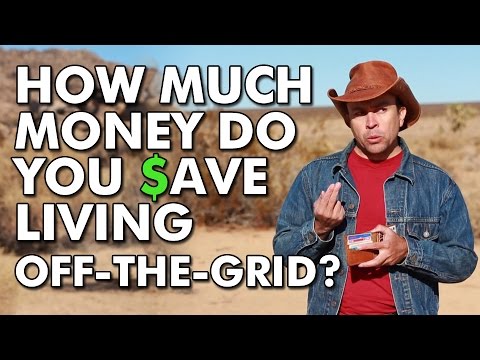
This post is a very dirty assessment of how off-grid living has saved me money and can help you do the same.
All my estimates will be for an average 4 person home in the United States. While the results will vary based on country, and locality, the overall premise will remain the same.
Alright, so my disclaimer: I’m not a scientist. I don’t pretend to be and I would rather never be one. I am an average, albeit hyper-logical, American so for my purposes, all of my numbers are very crude. I literally Google searched averages and I used the data from the most reputable looking website that came up. That said, we aren’t working on nuclear fusion, so I think crude logic is enough for our purposes here. Take all the averages with a grain of salt.
Also, I am using my home for the final calculations and comparisons. It is a 1400 sq ft earthbag construction open floorplan home, 50% bermed into a hill, with south-facing windows, and an energy efficient design. Your home may be bigger or smaller, so again, your numbers will vary.
Land
I will start at the beginning. Land. For our purposes, I will assume both properties will be on the same land. While in real life, someone living off-grid has very different land needs than someone linked-in, land varies in price so much from place to place that we will leave it as a constant in this example.
So both our example houses are built on a $20,000 20-acre plot of land. Difference= $0
Construction of linked-in home: (US avg) $200 per sqft x1400sqft = $280,000
Construction of Off-Grid home: (mine) $36 per sqft x1400sqft = $50,000
Savings: Off-Grid $230,000
Mind you the construction process was much slower and I had to do almost all my work by hand, the savings from construction of a home made of dirt compared to one made of conventional wooden frame and insulation are obvious.
Next are the infrequent expenses. Listed below are the appliances and expenses that one will have different than the other.
| Linked-In | Off-Grid | ||
| Toilet ea. (conventional) | $200 | Toilet (homemade compost) | $15 |
| Oil Tank | $700 | Solar Electric System | $10,000 |
| Water Heater (elec) | $600 | Solar Water Heater | $9,000 |
| Space Heating | $4,000 | Radiant Flooring | $5,000 |
| Air Conditioner | $750 | Cisterns (13,000Gal) | $6,400 |
| Total | $2,650 | Total | $30,415 |
Difference: $27,765 in favor of conventional homes. Ouch. The Linked-In setup has a much cheaper initial set-up price but if we look at the difference in cost of construction from above, I think we have this extra expense covered. Let’s see how we do when we look at our long term living expenses.
| Linked-In (per year) | Off-Grid (per year) | ||
| Water (non-toilet) | $360 | $0 | |
| Water (toilet) | $109 | $0 | |
| Space Heating (oil) | $600 | $0 | |
| Space Cooling (elec) | $374 | $0 | |
| Water Heating (elec) | $781 | $0 | |
| Water Heating (oil) | (no one has both) | $0 | |
| Electricity (non H/C) | $1200 | $0 | |
| Transportation (gas) | $2384/driver | $1200/driver | |
| Car Maintenance (no gas) | $3130/driver | $1500/driver | |
| Trash Disposal | $360 | $0 | |
| Total | $15,112 | $5514 | Assuming 2 drivers each |
Again, the estimates are approximate so there is definitely room for editing but on a whole, if you can work out your systems properly and modify your own home to your climate, you can cut down on your regular expenses dramatically. Additionally, I just cut the driving costs in half but ideally, if you are working at home, and producing 90% of your needs at home, your driving will be significantly less than even that. Additionally the wear and tear on your vehicle goes down as well as the wasted time driving.
So now lets total up our costs for the first five years of living whether we live off-grid or linked-in. (Is there a better expression than “linked-in”? I feel dumb using it but I can’t think of anything better. If so, please let me know.)
Conventional Build vs Off-Grid Home
Land: No difference. Home: 1400sqft home
| Conventional | Off-Grid | Savings | |
| Year One | -$297,762 | -$85,929 | $211,833(Off-Grid) |
Why such a large difference between them? First of all: labor. When you build off-grid, you can use alternative building methods that you can build by yourself or with the help of friends and family. My home is Earthbag construction. That means I took sandbags, filled them with dirt and stacked them in a staggered formation to build a wall. Not exactly rocket science. When you build your own home, not only do you get the satisfaction of living in a home you know you built yourself, you also save quite a bit of money in the process. The second source of saving by building off-grid: materials. Like I said, my home is made of dirt… literally dirt cheap. I save on lumber, shipping, specialized hardware etc. And it is better for my climate as I live in arid New Mexico and the thermal mass of earthen walls is welcomed from the incessant sunlight. Even the outer shell saves money. Where most people pay for siding, I use papercrete. I save the money, have a harder and longer lasting protective coating, and did it out of mostly recycled paper.
With all the money I saved by building a more efficient home using local and cheaper materials, I think the money I have to fork over for specialized equipment to sustain my off-grid lifestyle are a mere pittance.
I know what you are thinking. The cost benefits are amazing but what if I can’t/don’t want to build my entire house by hand? That would take forever and I don’t know how to build.
Even if you hire out for all construction labor and we pull the construction costs out of the equation, we show some pretty remarkable savings by living in off-grid systems alone.
| Conventional | Off-Grid | Savings (in favor of) | |
| Year One | -$17,762 | -$35,929 | $18,162 (Linked-In) |
| Year Two | -$32,874 | -$41,443 | $8,569 (Linked-In) |
| Year Three | -$47,986 | -$46,957 | $1,029 (Off-Grid) |
| Year Four | -$63,098 | -$52,471 | $10,627 (Off-Grid) |
| Year Five | -$78,210 | -$57,985 | $20,225 (Off-Grid) |
Basically, after an initial down payment bigger than conventional living, you save $10,000 per year by switching to an off-grid system and while it costs more up front for the equipment, the construction costs are usually lower (Smaller size homes with more efficient designs and alternative construction) and the savings make any savings concerns obsolete.
Now for the best part…..
None of those calculations factored in food or time spent at home with family. All those calculations assumed you shopped just as frequently and ate the exact same food from the same stores that you do now. (for real. Check again if you don’t believe me. Food wasn’t a factor) You will save $10,000 per year and not have to grow a single crop. Now let’s check on those who can also grow 80% of their own food.
The average family of four spends $1,000 per month on groceries alone. (And eats garbage processed food) This does not factor in the gas, or time consumed to get there and back. If you manage to grow half of your family’s dietary needs, you are saving another $6,000 per year on groceries. If you can grow over 80% of your food, you will save a total of $20,000 per year just by living off-grid. (use proper permaculture and efficient gardening techniques, lots of mulch and compost, and reuse your greywater to grow food cheaply)
You can save $20,000 per year by moving off-grid, growing your own food and providing for yourself. You make your own schedule, work for yourself, be your own boss, and have more free time. Your family eats healthier, cheaper, and is closer than they have ever been before. With all the benefits of living off-grid, is it any wonder why there is such a fast movement towards self-reliance? What is holding you back?
Additionally, according to a study by Harvard professors, an average American spends 101 minutes per day driving. This is broken down into 50 min in work related transportation and 51 minutes driving for everything else including errands, shopping, leisure, etc.
By cutting your expenses, living more efficiently, and providing for yourself as much as you can, you will be able to quit that job, save 8 hours per day of office work, and an additional hour and a half each day of wasted driving time. Who wouldn’t want to save 9.5 hours per day, every day? What would you do with all that new free time? Plant, learn, build, discover. Live.
Thanks for stopping by.
Auto Amazon Links: No products found.
